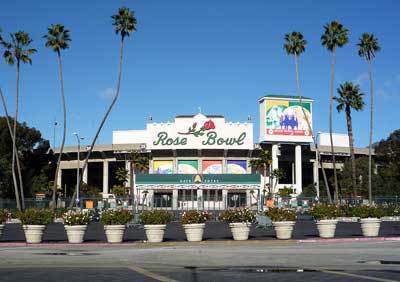Introduction
UCLA is like a city within a city, drawing more than 60,000 people daily to its 419- acre campus, nestled in the hills of west Los Angeles five miles from the Pacific Ocean. The “metropolis” of UCLA includes some ten libraries, two museums and an art gallery, three gardens, an elementary school, day-care facilities, residential complexes and buildings that house nearly 7,000 people, several theaters and performing arts auditoriums, stores, restaurants, gyms, a basketball arena, and a hospital. Additionally, the campus has its own police department, a chiller/cogeneration plant that assures the campus of low-cost power, hot water, and efficient cooling, its own postal system, a fleet of buses, and several newspapers.
I love the view from the top of Janss Steps. Looking west, you can see the residence halls rising above the green athletics field and Drake Stadium. In the distance are the Santa Monica Mountains. Looking east, you face the heart of campus, where Royce Hall and Powell Library, the campus’ oldest and most famous buildings, stand majestically. Between them is a beautiful quad area and a brick fountain. Just breathtaking!
In fact, UCLA and Los Angeles have nurtured one another through the years, ever since the precursor to UCLA, a two-year teaching college, was established in the little pueblo town of Los Angeles in the 1880s. As Los Angeles grew, so did UCLA. Founded in 1919, the university moved to its current Westwood home in 1929. From then on, both the school and the city enjoyed phenomenal growth and development. Today, Los Angeles has the second largest population in the United States, and UCLA educated 37,000 students and is the most popular university in the United States among applicants.
In just over eighty years, the university has earned a worldwide reputation for the excellence of its programs and the achievements of its students and faculty. It has distinguished itself as the only campus among the nation’s top ten research universities that was established in the twentieth century.
UCLA is a large and complex institution devoted to undergraduate and graduate scholarship, research, and public service. Known for academic excellence, many of its programs are rated among the best in the nation, some among the best in the world.
For more information, please visit www.ucla.edu.
UCLA really is the best of all worlds. Its prime location in metropolitan Los Angeles near the Pacific Ocean, Hollywood, and Los Angeles International Airport makes it an international gateway for culture and entertainment. The climate here is mild and pleasant all year. UCLA itself, as one of the finest research universities in the world, draws top scholars and scientists from around the globe, prime research dollars, worldwide attention for its cutting-edge research, and a reputation for all-around excellence. Many of its academic programs are ranked in the top ten nationally. Its medical center has been named the best hospital in the western United States for the thirteenth straight year. It is a leader in new technology. UCLA is one of the top athletics schools. It is known for the diversity and quality of its student body.
And UCLA’s reach can be felt all over the city, nation, and world, as the campus and its people outreach to those in need, from poverty-stricken inner-city Los Angeles families to war refugees. Both UCLA Extension, which is the largest urban-based continuing education program in the United States, and the Medical Center have several satellite sites to serve those all over the city. Professors conduct research in all parts of the world, and their work—whether it’s laying the groundwork for the Internet or finding a cure for AIDS— affects everyone.
Not only that, but UCLA is, from anyone’s perspective, a beautiful campus. The handsome red brick and terra-cotta Romanesque buildings at the center of campus evoke distinction and refinement, while some of the newer buildings shout innovation and creativity, and the gorgeous landscaping, striking architecture, and stunning views lend an inherent harmony to the entire campus.
No wonder UCLA is the most sought-after school in the nation!




